How to determine foot arch type
Are your feet… really good for running? Running has the most common arch problems
Many people do not know that they are flat feet!
It also makes them more susceptible to injuries, such as Plantar fasciitis, when they run.
What kind of arch is abnormal, and what’s the harm? Are abnormal arches really bad for running?
Today’s article gives you the answer!
Your Arches, are they normal?
First, let me show you two simple ways to measure your arch.
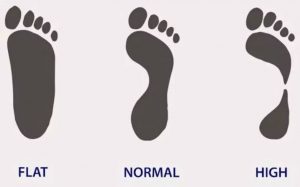
01 experimental method
Take off your shoes and socks, dip your bare feet in water and then step on the concrete floor. Judging by the images printed on the floor, the normal footprints should be those of the forefoot and heel clearly and completely, the middle of the foot is about one third the width of the forefoot, and the whole footprint looks like a concave character when it is across, there’s no obvious bump, and the tread looks approximately rectangular across.
02 rough estimate
The normal scaphoid tubercle is about 1.5 cm off the ground and can be inserted about the width of a transverse finger. This is a good way to check your arches.
By the above method, you can basically determine their own arch, in the end is normal.
What is the difference between normal and abnormal arches? What’s the harm in having an abnormal arch?
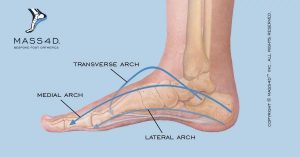
The arch of the foot is a convex upward arch formed by the union of the tarsals and metatarsals. The arch of the foot is dynamic and constitutes an integral functional complex with muscles and ligaments.
The arch of the foot increases the elasticity of the foot, making it an elastic “Tripod”. Very few people know, in fact, the newborn baby is no arch of the foot, the arch of the foot is accompanied by the growth and development of the human body, it is not so much an inherent organ of the human body, rather, it is the product of human labor.
The weight of the body is transferred from the ankle joint through the talus to the metatarsal head and calcaneal tubercle, so as to guarantee the stability of the plantar landing support when standing upright, and to play the role of elasticity and shock absorption when walking and jumping.
The arch also protects the blood vessels and nerves in the soles of the feet from compression, reducing the impact on the body and protecting internal organs, especially the brain, from concussion.
01 what is an abnormal arch
The maintenance of the arch of foot depends not only on the connection of the bones, but also on the traction of the ligaments of the sole and the tendons of the long and short muscles. Although these ligaments are very tough, they lack the ability to contract actively. If they are stretched or damaged, they can become flat feet, also known as arch collapse.
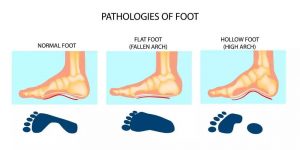
Flat foot is defined as the absence or inconspicuous medial arch of the foot and the large contact area between the flat sole and the ground. There are also two common conditions, one is that the arch does not exist even when the weight is not on, and the second is that the arch collapses when the weight is on.
The opposite of a flat foot is the claw foot, also known as a high arch. The height of the arch was more than two fingers when standing normally. It is less common than flat feet and is about a third as common. Patients with high arch foot tend to be stiff, the ability to buffer shock worse and lead to plantar pain.
In addition, people with high arches also have a greater impact on their knees when running, and those with high arches are advised to opt for running shoes with better cushioning, such as Adidas Boost, Brooks Gly 14ghost8, Saucony Triump Hurricane.
Damage of abnormal arch of Foot
Flat Feet:
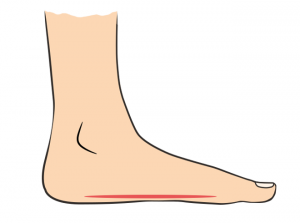
Height reduction, will generally affect 0.5 cm or so of height difference.
Wide forefoot, can’t find the right shoes! Shoes with the right foot length are too narrow and shoes with the right width are too long. All the year round to give oneself “Wear small shoes”not to say, but also special expense shoes.
Flat feet cause the second and third toes to increase the contact area with the ground, increased friction, easy to grow calluses.
High Arches:

Because the arrangement of the bones of the forefoot leads to the increase of the tension of the flexor muscles of the foot, the injury of the plantar arch is easy to occur.
Because the arch of the foot is under stress for a long time, it is more likely to induce Plantar fasciitis.
People with high arches have even worse cushioning effects on the reaction than those with flat feet, and are therefore more likely to have knee injuries.
Can you run with an abnormal arch?
This is a crucial question.
01 biomechanical analysis
Flat feet and high arches are not strictly a disease. It is more close to the bad adaptation result of the body to the mechanical load environment. So it takes a lot of training to rewire the foot.
One conclusion is that people with abnormal arches should run, be determined to run, even more than those with normal arches.
In particular, the word “Run”here refers not to a run that exceeds the average person in terms of volume and intensity, but rather to a process that requires a relearning of the landing cushion to the stride. Through long-term training, improve the anatomical characteristics and physiological functions of the muscles, tendons and ligaments related to the foot.
02 special program for runners with Abnormal Arch
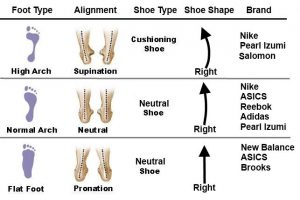
The solution we recommend is for flatfoot patients:
The first stage, the use of arch pad under the premise of non-reduction training. That is, how long you normally run, you still run. However, due to the function of the arch pad, as to the plantar arch bridge, the force will be scattered to the sides and strings, so that the plantar pressure re-distribution. The high peak pressure and pressure at the second and third toes were relieved.
In the second stage, continue to use the arch pad and increase the amount of training, but not more than 20% of the amount of training. In the third stage, remove the arch pads and return to your normal training volume. The first stage should last about 2 weeks, and the second stage should last 1-2 months.
The third stage, 6 ~ 8 weeks, the overall program time maintains about 4 months. Re-use the previous method or go to a professional sports medicine clinic, Sports Hospital to re-evaluate the arch. Even if there is no significant improvement in the bone structure of the arch, a complete strengthening of the soft tissue will go a long way toward improving your long-distance running performance.
For patients with high arches:
In the first stage, it is recommended to use the arch pad for weight reduction training. For those who usually run 5K every day, running 3 ~ 4K is recommended, because the patients with high arch are in a state of tension for a long time, and the plantar ligaments are more likely to relax. A certain degree of curvature and the height of the arch pad, so that the flexibility of the ligament has been a certain recovery.
In the second stage, take off the arch pad and do weight reduction training. The amount of training is the same as in the first stage. In the third stage, take off the arch pad and gradually transition to the regular training volume. The advantage of this method is that it can protect the stability of plantar structure as much as possible, and improve the elasticity of plantar fascia and stimulate the body to restore normal physiological structure and function.
03 strengthening two points of consciousness in the process of rehabilitation
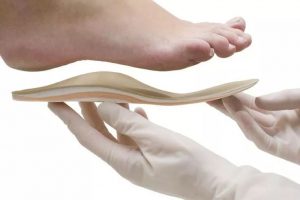
The point is that students with abnormal arches should consciously develop two points of awareness:
First, awareness of the three supporting points of the sole, namely the base of the big toe, the fourth and fifth toes, and the heel;
Second, the sense of sequence in normal gait, i. e. landing on the outside of the heel first, then transitioning from the middle outside of the foot to the forefoot, then to the base of the big toe, and finally pushing off the ground through the Big Toe。
04 Treatment of abnormal arch of Foot
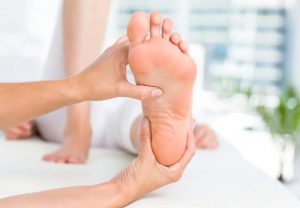
01 surgery: Surgery is also a way to correct the arch of the foot, but the vast majority of flat foot athletes do not need surgery to correct the situation.
02 orthotic insoles: as 3D printing technology matures, more and more high-end manufacturers are offering customized insoles, such as full palm insoles, arch insoles, forefoot cushioning pads, and heel insoles.
03 passive rest and active relaxation: this includes free-hand massage (for example, patients with high arches can press their hands toward the middle of the foot and then relax to the sides), and volar massage with a tennis ball, etc. , practice with the elastic band (use the elastic band around the sole, one hand holding both ends of the elastic band pull up, each group lasts 30 seconds, repeat 3 groups) warm water feet, acupuncture and so on.
04 rehabilitation: mainly involves creating unstable surfaces for small muscle groups, such as standing on one leg at the edge of a step; standing and squatting on a bosuqiu (a rehabilitation device); resistance to heel lifts.
A quick summary
You think the dry stuff up there is very dry! More articles on abnormal arches, including rehabilitation and running postures, will follow, and this article will briefly summarize:
01 the arch of the foot increases the elasticity of the foot, which can play the role of stability of the plantar landing support, and play the role of elasticity and shock absorption when walking and jumping.
02 abnormal arches each have their own hazards but do not run because of their abnormal arches, abnormal arches should run more. Pay attention to relearning the cushioning process from landing to stepping. Through long-term training, improve the anatomical characteristics and physiological functions of the muscles, tendons, and ligaments related to the foot.
03 you can tell if your arch is normal or abnormal by dipping your foot into the water and treading on the ground. There is a difference between flat and high arches, and it needs special attention.
The collapse of transverse arch of foot may cause local connective tissue degeneration. What we call Plantar fasciitis is in many cases the result of flat-footed people continuing to exercise when they don’t notice or value it.
Valgus feet, it is worth noting that not all flat feet can cause valgus feet, not all valgus feet are developed from flat feet.
Source by: https://zhuanlan.zhihu.com/p/55398441
Hot blogs:
The Easiest Custom Insoles: Heat Moldable Insoles
Custom insoles, also known as orthotic insoles, are designed to provide personalized support and comfort for individuals with various foot conditions. In [...]
Children’s Insole Size Conversion Chart
The standard sizes for shoe insoles may vary from country to country, making it a headache to choose the right insole for [...]
Do custom orthotics need to be made by a doctor personally?
Custom orthotics do not necessarily need to be made by a doctor personally. While doctors, specifically podiatrists or orthopedic specialists, are often [...]
Do NBA players use custom insoles?
Custom insoles are not only helpful for people with foot health issues, but they also play a significant role in targeting the [...]
